The Great Lakes Basin Bookshelf—Fall 2025 Reading List.
The Great Lakes Basin is full of stories. They live in the jagged shorelines of the Upper Peninsula, the small towns tucked along Lake Erie, and the historic harbors of Ontario. They’re in the water, the trees, the rusting steel towns, and the people who’ve built their lives here.
Fall is the perfect time to curl up with a good book—whether it’s on a cabin porch, a lakeside bench, or your favorite chair at home—and let a great story pull you in. To help you get started, here are five authors with deep ties to the Great Lakes Basin whose work captures its spirit, struggles, and beauty.
Each of these writers brings a different lens to the Great Lakes Basin Region. Some are novelists, others essayists or poets, but they all share a deep connection to this place. Their books will take you from rural backroads to industrial towns, across the open water and into communities that might feel a lot like your own.
So grab a copy, pour yourself something warm, and get lost in a Great Lakes story this season.
Jim Harrison (Grayling, Michigan)
Jim Harrison (1937–2016) is practically synonymous with northern Michigan. Known for his sharp observations and his love of the outdoors, Harrison’s work often draws on the forests, rivers, and rugged shorelines of the Upper Peninsula.
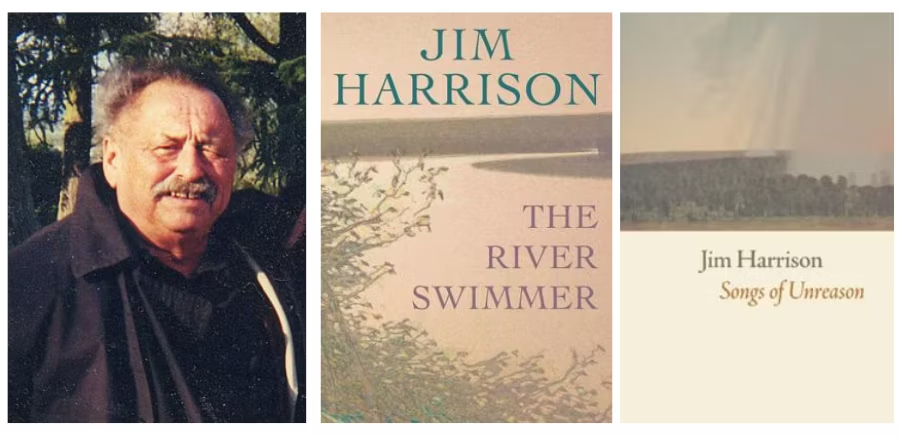
He’s perhaps best known for Legends of the Fall, the novella-turned-film, but Harrison’s body of work runs deep. His Dalva novels weave together family history and contemporary life in the Great Plains and northern Michigan, and his poetry captures the Basin’s wilderness and solitude in a way that few others can.
Suggested reading
The River Swimmer (novellas). The River Swimmer is Jim Harrison stripped down and wide open. Two stories, two men, both caught between the mess of love and the slow vanishing of the wild. In The Land of Unlikeness, a burned-out artist returns to his family farmhouse in Michigan, only to be pulled under by memory—old lovers, broken family ties, and the ache of a life that once meant more. Then in The River Swimmer, Harrison wades into something deeper—a boy from the Upper Peninsula who sees visions in the water and feels an unshakable need to swim away from everything. What unfolds isn’t just myth or metaphor—it’s the raw, mystical pull of freedom, survival, and the strange, sacred weight of becoming who you really are.
Songs of Unreason (poetry). Songs of Unreason doesn’t just explore the world, it sinks into it. Jim Harrison writes like someone who remembers the land with his whole body. These poems feel old in the best way—animal, instinctual, unfiltered. He even admits it might rattle the over-educated. The lines move between short, quiet jolts and longer stories that feel more lived than written. And through it all, he circles back to what lasts: creeks and underbrush, passing time, the strange comfort of loving what’s already gone. It’s tender and brutal at the same time. Grounded, but always moving.
Bonnie Jo Campbell (Kalamazoo, Michigan)
Bonnie Jo Campbell’s fiction is rooted in rural Michigan, particularly the area around Kalamazoo, and it doesn’t shy away from the grit and complexity of small-town life.
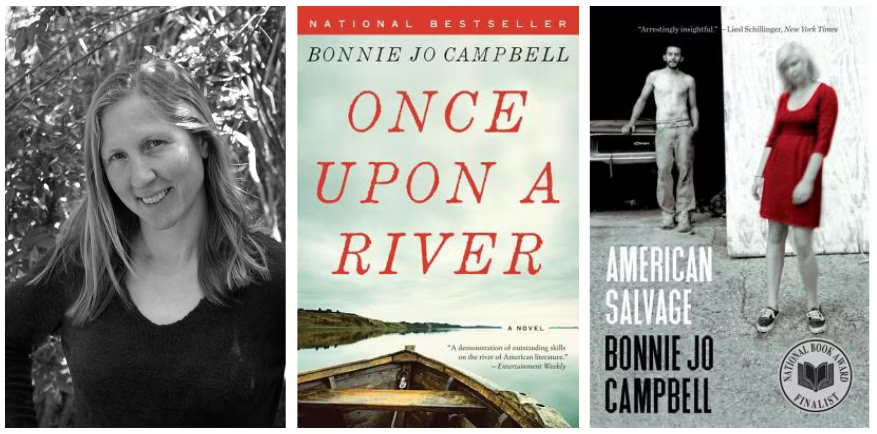
Her short story collections American Salvage and Women & Other Animals earned her national recognition for their unflinching portrayals of the struggles—and humor—of people living on the margins. Her novel Once Upon a River follows a teenage girl navigating the waterways of Michigan’s rural landscape, a coming-of-age story that reads like a modern-day Huck Finn set in the Great Lakes Basin.
Suggested reading
Once Upon a River (novel). Once Upon a River is a gritty, hauntingly beautiful coming-of-age story that follows sixteen-year-old Margo Crane as she flees a violent family tragedy and sets off alone down Michigan’s Stark River. Armed with a rifle and a quiet, stubborn strength, Margo drifts through a world of danger, tenderness, and raw survival—learning how to live off the land and navigate the brutal, complicated terrain of human connection. Bonnie Jo Campbell writes with the kind of sharp honesty that doesn’t flinch, letting the river carry Margo—and us—through grief, longing, and the aching pursuit of freedom.
American Salvage (short stories). American Salvage is rough-edged and unflinching—a collection of stories that drags you into the backroads of Michigan, where people are hanging on by their fingernails and still somehow reaching for something like grace. Bonnie Jo Campbell doesn’t romanticize rural life; she shows it cracked and raw, full of meth, loss, stubborn love, and the kind of resilience that doesn’t look pretty but damn well survives. These characters aren’t easy, and their lives sure as hell aren’t clean—but every story pulses with something real, something that lingers like smoke on your clothes long after you’ve put the book down.
David Giffels (Akron, Ohio)
Daivd Giffles is a non-fiction writer who explores the challenges and resilience of Rust Belt communities. Based in Akron, Ohio, Giffels writes about what it means to love a place that has been through economic decline and reinvention.
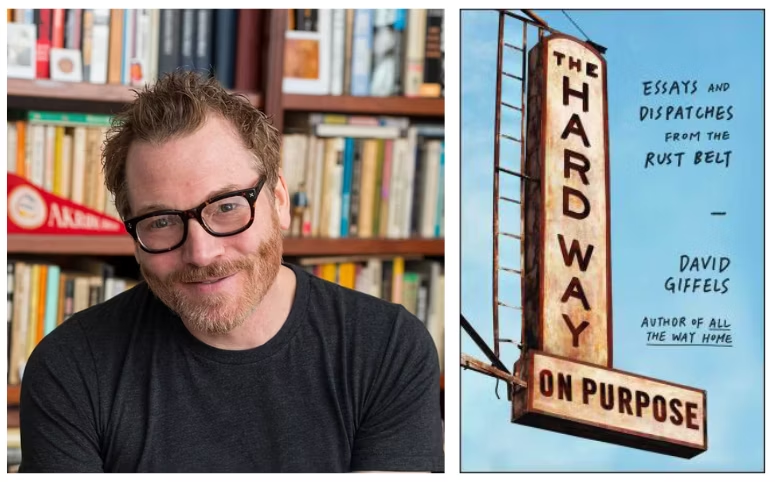
His book The Hard Way on Purpose: Essays and Dispatches from the Rust Belt is part memoir, part love letter to Northeast Ohio, and a must-read for anyone who wants to understand the character of the Basin’s industrial towns. His follow-up, Furnishing Eternity, is a moving meditation on mortality, family, and making things by hand.
Suggested reading
The Hard Way on Purpose (essays). The Hard Way on Purpose feels like a lived-in conversation with someone who’s seen the Rust Belt at its best and worst, and still loves it anyway (many of us can relate to that). David Giffels doesn’t sugarcoat a damn thing. He writes about Akron—and everything it’s lost—with grit, dark humor, and the kind of affection that only comes from staying put when everyone else leaves. These essays are full of heartbreak and weird pride: burned-out factories, hopeless sports teams, and the people who keep showing up anyway. It’s a reminder that identity isn’t always found in success; it’s forged in what we survive.
Jane Urquhart (Geraldton, Ontario, Canada)
Jane Urquhart is one of Canada’s most celebrated novelists, and much of her work is set along Lake Ontario’s shoreline. She grew up in Northumberland County, which hugs the northern edge of the lake, and her novels often weave together history, family, and the physical landscape.
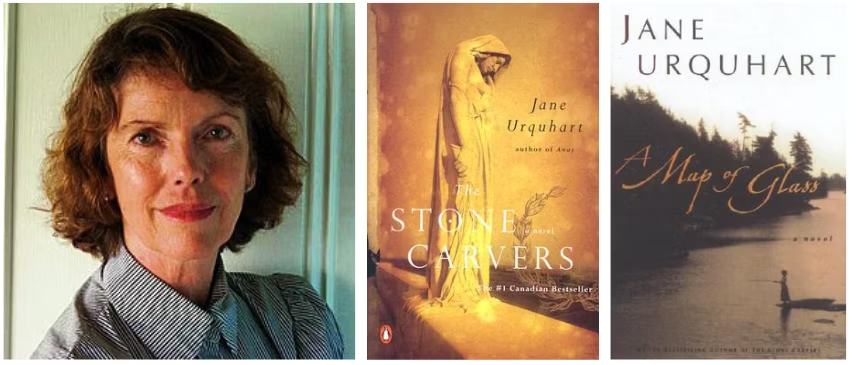
In The Stone Carvers, Urquhart explores art, love, and war through the story of a small Canadian village and its residents’ ties to Europe during World War I. Her novel A Map of Glass blends environmental themes with a haunting narrative set on the Lake Ontario shore.
Suggested Reading
The Stone Carvers (novel). The Stone Carvers is a sweeping, carved-in-bone novel that feels like witness to history through human hands. Jane Urquhart spans generations—from a German-Canadian priest’s ambition in remote Ontario to the harsh trenches of World War I—and lands in the quiet ache of an aging sister and her wayward brother. Art isn’t a luxury here, it’s survival. Klara chisels grief into stone; Tilman roams and returns as a wounded man. The building of the Vimy Memorial becomes both literal and symbolic redemption, and Urquhart doesn’t shy from sentiment, though at times it leans toward ornate. Still, moments of beauty—mud-slicked Bibles plowed up in spring, a carved torchbearer wearing a lost lover’s face—stay with you. It’s a novel about how making something lasting can build a life worth inheriting.
A Map of Glass (novel). A Map of Glass is slow, haunted, and quietly devastating. It’s the kind of novel that unfolds like memory itself: out of order, half-lit, and deeply felt. It starts with a man disappearing into the snow and unravels from there—through an artist, a historian, and generations of people tied to a shifting landscape. Jane Urquhart isn’t in a rush. She lets the story breathe, full of weathered shorelines, ghosted relationships, and the fragile threads that connect us to place and to each other. It’s not always easy, but it lingers—like fog off the lake or a name you almost remember.
Mona Hanna-Attisha (East Lansing, Michigan – born in England)
Dr. Mona Hanna-Attisha is a pediatrician, scientist, and public health advocate whose book What the Eyes Don’t See chronicles her role in exposing the Flint water crisis.
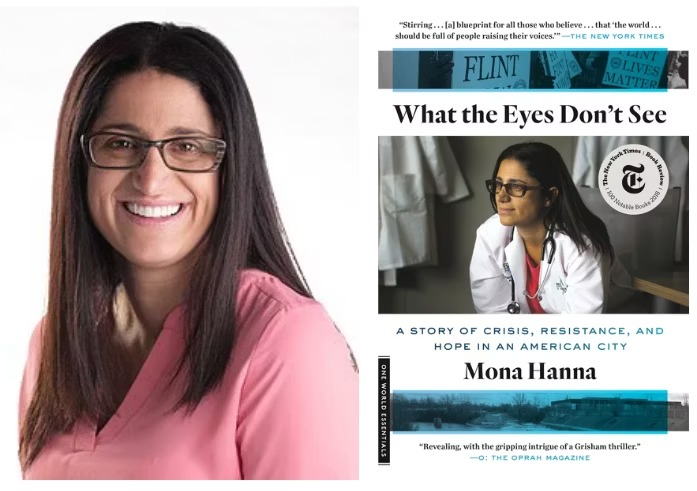
Part detective story, part memoir, What the Eyes Don’t See is as gripping as any thriller, but it’s real life—and it shows how one determined person can make a difference. Hanna-Attisha’s work is an essential read for anyone who cares about the health of the Great Lakes and the people who live here.
Suggested reading
What the Eyes Don’t See (non-fiction). What the Eyes Don’t See is the story of Flint told through the eyes of Dr. Mona Hanna‑Attisha, the pediatrician who uncovered the lead poisoning that should have killed the city’s children—and instead became its wake‑up call. She writes with urgency and grit, weaving her own immigrant-family history, medical detective work, and gut‑level outrage into a narrative about broken democracy, environmental racism, and collective responsibility. What starts as a trusted colleague casually warning her that Flint’s water might be toxic turns into a full‑blown crusade—data‑mining blood tests, confronting state denials, taking on bureaucrats. And even when the backlash hit like a wave, she stayed—fueling a community-wide fight that forced national reckoning and action. It’s a wrenching, hopeful book about science, resistance, and what it takes to demand justice when the vulnerable are being poisoned.
CALL TO ACTION
Who’s your favorite Great Lakes Basin Region author? Which books should be on our reading list? Tag us @GreatLakesPulse on all social media and let us know—you might help us discover the next author to feature.
Note: links to purchase books are affiliate links through Bookshop.org, except for A Map of Glass. If you purchase through the link, we will receive a small commission, which will help fund our Love Where You Live Foundation. Thank you for support.











